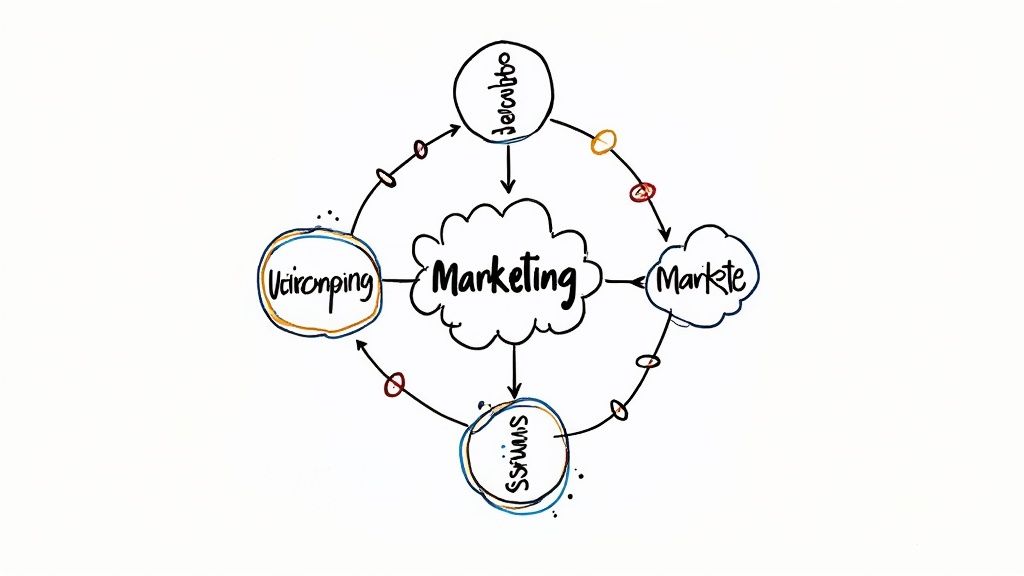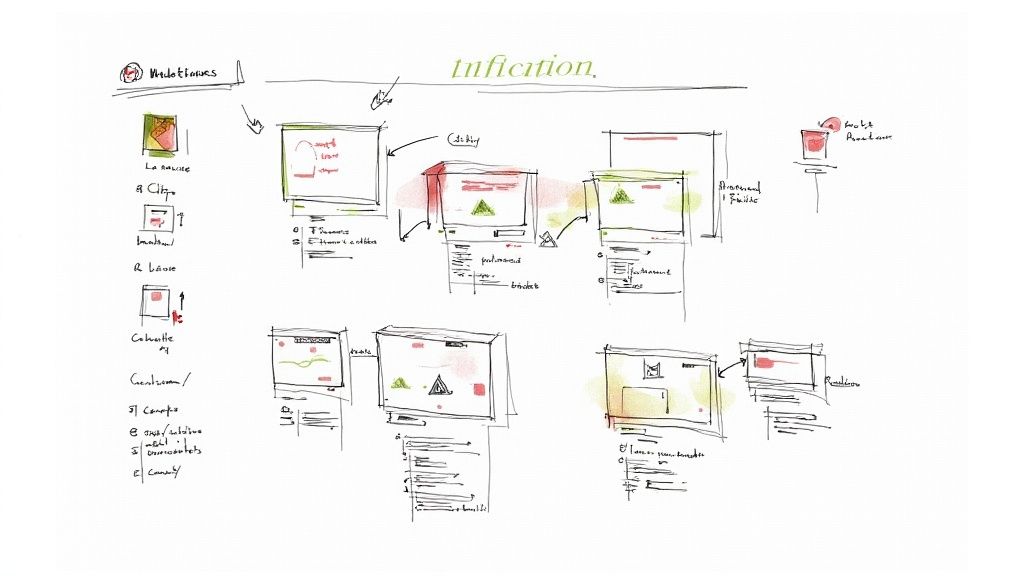Marketing Automation: Proven Best Practices
Building the Business Case for Marketing Automation

When considering investment in marketing automation, the numbers tell a compelling story. Companies earn an average return of $5.44 for every dollar spent on marketing automation over three years. This isn't just luck - it's a consistent pattern seen across successful businesses. In fact, 72% of high-performing marketing teams use automation to achieve strong results. These statistics show why following proven marketing automation best practices pays off.
Demonstrating the Value of Automation
Making the case for automation means showing how it solves real business problems. Start by identifying your organization's specific challenges. If you struggle with lead generation, show how automation can improve lead nurturing through personalized messaging that boosts conversions and revenue. Beyond leads, highlight how automation frees up your team from repetitive tasks. This allows them to focus on strategic work that drives business growth. The key is connecting automation capabilities directly to measurable business goals.
Key Metrics for Measuring Success
To prove automation works, you need to track metrics that matter. While email open rates and clicks provide useful data points, focus on metrics tied to business outcomes. These include conversion rates, cost per lead, customer lifetime value, and return on investment. For example, if your goal is generating more sales-qualified leads, measure how many leads nurtured through automated workflows become real opportunities. Regular monitoring of these key performance indicators shows the concrete impact of your automation efforts.
Building a Realistic Timeline and Avoiding Pitfalls
Setting realistic expectations about implementation and results is essential. Most companies see returns within six months, but automation's full benefits emerge gradually through ongoing optimization. Rather than trying to automate everything at once, start with a focused pilot project in one area like lead nurturing or email campaigns. This lets you refine your approach and demonstrate wins before expanding. Make sure your team gets proper training to manage the platform and analyze its data effectively. Taking this measured approach while following marketing automation best practices creates a foundation for lasting success.
Crafting Your Lead Generation Engine
Building a solid marketing automation platform is just the beginning - the real impact comes from creating an effective lead generation system. This means developing processes that consistently attract qualified leads and guide them through your sales funnel. Companies that master these capabilities see dramatic results, with studies showing up to a 451% increase in qualified leads after implementing robust marketing automation.
Behavioral Tracking and Progressive Profiling: Getting to Know Your Leads
Understanding how potential customers interact with your content is essential for generating high-quality leads. Think of it like a skilled salesperson who remembers every conversation and interaction with a customer. By tracking website visits, content downloads, and email engagement, you build a detailed picture of what interests each lead.
This understanding enables progressive profiling - gathering information gradually instead of all at once. Start with basic contact details, then ask for more specific information based on how leads engage with your content. For instance, after someone downloads an ebook about email marketing, you might ask about their current email list size or campaign goals. This approach feels more natural to leads and results in better form completion rates and more useful data for personalizing future interactions.
Dynamic Content and Lead Scoring: The Perfect Match
Once you have solid data about your leads, you can deliver content that matches their specific interests and needs. Just as Netflix suggests shows based on viewing history, dynamic content adjusts what each lead sees based on their profile and past behavior. When combined with lead scoring, this creates a powerful system for connecting with potential customers.
Lead scoring helps identify your most promising prospects by assigning points for specific actions - like downloading resources, attending webinars, or viewing pricing pages. This creates a clear priority system for your sales team, helping them focus on leads most ready to buy. By matching targeted content to specific lead segments and using scoring to track engagement, you can significantly improve your conversion rates.
Nurturing Sequences that Convert: Guiding Leads Through the Sales Funnel
The final piece is creating nurturing sequences that move leads naturally through your sales process. This means sending the right content at the right time based on where each lead is in their buying journey. A new subscriber might receive helpful getting started guides, while someone closer to purchase gets case studies and product comparisons. This methodical approach builds trust and keeps leads engaged until they're ready to buy. Think of it as having a conversation that naturally progresses from introduction to close, but automated to scale across hundreds or thousands of leads.
Mastering the Art of Email Automation

Email automation plays a key role in moving leads through your sales funnel and driving conversions. But success requires more than just scheduling some automated messages - you need carefully designed sequences that connect with subscribers at the right moments. Let's explore proven email automation strategies that can help boost your revenue by up to 320%, according to industry data. The focus isn't just on improving open rates, but on creating campaigns that genuinely drive sales.
Building Engaging Welcome Series
Your welcome sequence makes that crucial first impression on new subscribers. Instead of a basic "thanks for signing up" message, create a series of emails that provide real value while building a connection. For example, if you run a SaaS company, your welcome sequence might include a free trial offer followed by helpful tutorial videos showing key features. This approach gives subscribers immediate benefits while naturally guiding them toward becoming customers.
Recovering Lost Sales with Abandoned Cart Emails
Cart abandonment emails are one of the most effective ways to recapture lost sales - research shows they can recover up to 25% of abandoned purchases. The key is timing and incentives. Send your first reminder within an hour after abandonment, when interest is still fresh. Follow up after 24 hours, possibly with free shipping or a small discount. A final reminder at the 72-hour mark can help convert those still on the fence. This gentle but consistent approach often brings customers back to complete their purchase.
Triggered Emails for Personalized Engagement
While welcome and cart recovery emails are essential, the real power of automation comes from behavior-based triggers. When someone takes a specific action, like downloading your social media marketing guide, you can automatically send them related resources on that topic. This feels more like helpful guidance than promotional messaging. Similarly, product recommendations based on past purchases show you understand their interests. These personalized touches create stronger connections that lead to better engagement and sales.
Optimizing Your Email Automation Strategy with A/B Testing
Getting the most from your email automation requires ongoing refinement through A/B testing. Try different subject lines, email copy, calls-to-action and sending times to see what works best. A simple test comparing personalized versus generic subject lines can reveal valuable insights about what makes subscribers click. Use the data to keep improving - careful optimization can boost click-through rates by 34% or more. The key is to treat your automation as an evolving system that gets better over time as you learn what resonates with your audience.
Integrating AI for Smarter Automation
Marketing automation works well on its own, but adding AI capabilities makes it even more effective. When marketing teams combine automation with AI, they often see better results and higher conversion rates through smarter personalization. Let's explore practical ways to add AI that make sense for different budgets and business needs.
Predictive Analytics: Anticipating Customer Needs
AI is particularly good at analyzing patterns to predict what customers might do next. By looking at data from website visits, past purchases, and email interactions, AI can spot trends that help marketers understand future behavior. For instance, when someone regularly looks at hiking gear on your site, AI can trigger emails about new outdoor equipment or relevant sales. This shifts marketing from just responding to past actions to getting ahead of customer needs, which typically leads to more sales.
Behavioral Targeting: Delivering the Right Message at the Right Time
Good timing matters in marketing, and this is where AI really helps. Picture sending a discount for running shoes right after someone reads about marathon training - that's AI-powered behavioral targeting in action. Instead of just grouping people by age or location, this approach responds to what customers are doing right now. The messages feel more relevant because they match the customer's current interests and activities.
Dynamic Content Optimization: Personalizing at Scale
Just like Netflix suggests movies based on what you've watched, AI helps marketers show different content to different people. Your website, emails, and even buttons can change based on who's looking at them. Each visitor might see slightly different versions of your marketing materials, making them more likely to connect with what they see and take action.
The Human Element: Where Expertise Still Matters
While AI is a powerful tool, it can't replace human judgment and creativity. AI excels at processing data and automating repetitive tasks, but marketers still need to guide the strategy and craft compelling messages. Take trending topics - AI can spot what's popular, but marketers understand why people care and how to create content that connects emotionally. The best results come from combining AI's data analysis with human insights to create marketing that really works.
Building Seamless Cross-Channel Workflows

The most successful marketing automation strategies connect seamlessly across multiple channels. When you thoughtfully coordinate experiences between email, social media, your website, and offline touchpoints, you create deeper connections with customers and drive better results. Picture this: A customer browses products on your site, which automatically triggers a personalized email showcasing similar items with a special discount code. They then see social proof through targeted social ads featuring real customer reviews of those exact products. This natural progression feels helpful rather than pushy, making customers more likely to purchase.
Data Synchronization: The Foundation of Cross-Channel Success
For cross-channel marketing to work, your data needs to flow smoothly between systems. Think of it like a recipe - all ingredients must work together in the right proportions to create something delicious. When a customer updates their contact information in your HubSpot CRM, those changes should instantly sync to your email platform, social targeting, and website personalization. This keeps every interaction relevant and prevents the friction of outdated or conflicting information reaching your customers.
Trigger Strategies That Actually Work
Smart triggers respond to specific customer actions with meaningful, well-timed messages. The key is creating triggers that genuinely help customers move forward in their journey, not just blast them with generic promotions. For example, you might set up a friendly welcome series when someone joins your email list, send a gentle reminder with a discount when they leave items in their cart, or suggest products based on what they've been browsing. Each automated message should feel like a natural extension of their interaction with your brand.
Workflow Optimization: Streamlining for Efficiency
Building cross-channel workflows is just the start - you need to regularly fine-tune them for peak performance. Review your email metrics to spot which subject lines and content drive engagement. Track how different channel combinations impact conversions. Look for manual tasks that could be automated, like scoring leads or segmenting customers, so your team can focus on strategy and creativity. Regular optimization keeps your automation working hard toward your business goals.
Troubleshooting Common Integration Challenges
Connecting multiple marketing channels often comes with hurdles to overcome. Data silos are a common problem, where valuable customer information gets stuck in separate platforms instead of flowing freely between them. Clear brand guidelines help maintain consistent messaging across channels. Technical issues can also disrupt your carefully planned workflows. Set up monitoring systems to catch problems early, and create backup plans for critical automations. By planning ahead for these common challenges, you'll keep your cross-channel experiences running smoothly.
Measuring and Scaling Success

The success of your marketing automation efforts depends on consistently measuring performance and making data-driven improvements. Rather than focusing solely on basic metrics like open rates and clicks, you need to track key performance indicators (KPIs) that directly tie to your business goals. For instance, if you aim to generate more qualified leads, monitoring how many leads convert through your automated workflows becomes essential. By analyzing this data, you can fine-tune your strategies to drive real growth.
Identifying Key Performance Indicators
The KPIs you choose should clearly show how well your marketing automation supports your main business objectives. Here are some important metrics to track:
- Conversion Rates: Track what percentage of leads take desired actions like completing forms, downloading content, or making purchases. This shows how well your nurturing sequences move people through your sales funnel.
- Cost Per Lead (CPL): Calculate your spending to acquire each new lead. Getting high-quality leads at a lower cost indicates your automation is working efficiently.
- Customer Lifetime Value (CLTV): Look at the total revenue each customer generates over time. Growing CLTV shows your automation builds lasting customer relationships.
- Return on Investment (ROI): Measure the overall financial return on your marketing automation spending. This bottom-line metric proves the value of your strategy.
Regular review of these metrics helps spot opportunities to improve your workflows for better results.
Analyzing Performance and Optimizing Campaigns
Good analysis means understanding why certain metrics look the way they do, not just collecting numbers. If conversions are low, you may need to examine your landing page design, calls-to-action, or content relevance. Getting to the root cause requires diving deep into the data.
Make improvements methodically through A/B testing different elements like email subject lines, button text, and page layouts. This gives you clear evidence of what connects with your audience. Keep testing and refining to steadily boost your campaign performance.
Scaling Your Automation While Maintaining Quality
As you expand, you'll need to scale up your marketing automation thoughtfully. The goal is reaching more people while keeping the personal touch that drives results. Advanced audience segmentation is key - create smaller groups based on behaviors, demographics and interests to send highly relevant messages to each segment. This focused approach maintains engagement even with a growing audience.
You can also use dynamic content that adapts to individual preferences automatically. When each lead gets personalized experiences, they're more likely to convert. The key to scaling is finding the sweet spot between broader reach and individual attention.
Troubleshooting Underperforming Campaigns
It's normal for some campaigns to underperform. What matters is having a clear process to identify and fix issues. Start by comparing actual results to your original KPI goals. If there's a big gap, investigate potential causes: Are you reaching the right audience? Is your content engaging? Do your calls-to-action work?
Take a systematic approach to troubleshooting. Check your workflow logic, email delivery rates, and get input from your sales team. This helps uncover the real reasons for poor performance. Often, adjusting your targeting, messaging or timing can get campaigns back on track.
Empower your business with personalized, intelligent customer interactions. Sitebot's AI-powered chatbots are designed to boost engagement, streamline support, and drive conversions. Visit https://sitebot.co and transform your customer experience today!


